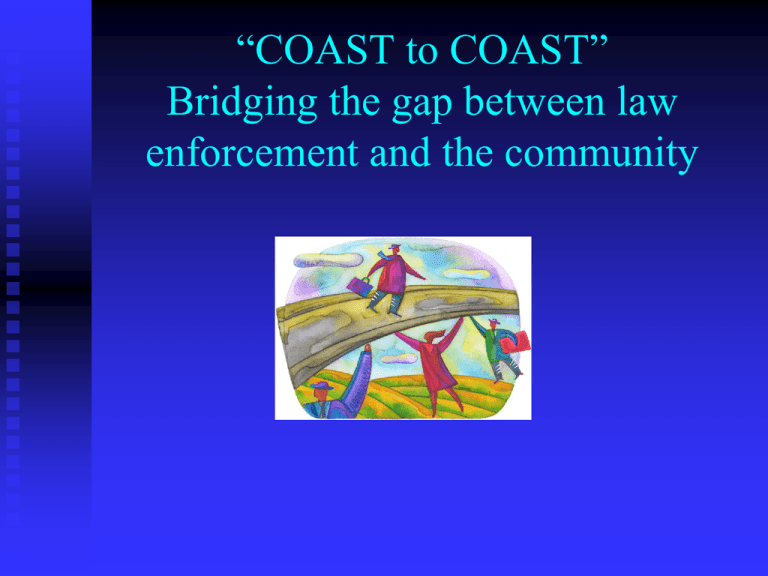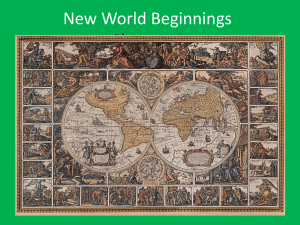COAST-What is it? - CIT International Conference
advertisement

“COAST to COAST” Bridging the gap between law enforcement and the community Presented by: Albuquerque Police Department’s CRISIS OUTREACH & SUPPORT TEAM (COAST) Goals and Objectives What is COAST? Best Practices- Engage, Assess, and Resolve Strategies to build or enhance your community based program COAST-What is it? Crisis Outreach and Support Team Civilian Unit Created to: Enhance the Albuquerque Police Department’s Crisis Intervention Team (CIT). Provide crisis intervention to people through direct referrals from field officers. On scene response to field officer’s request for assistance. Follow up calls or visits from officer’s report. Why COAST? People cycle in and out of crisis causing repeated calls to police for non-law enforcement issues. Proactive resource in decreasing unsafe situations for individuals, the community, and law enforcement. Linking these people to services and resources is the best way to minimize these calls for police service. COAST- its conception July, 2003 APD Sgt. Carol Oleksak was shot by Duc Pham, a man with history of Homelessness Untreated mental illness Over 50 Misdemeanor arrests (released because no proof he was dangerous) Incompetent to stand trial-every case! No supportive services Sgt. Carol Oleksak returned to police department to finish up her 20 year career advocate for people living with mental illness has forgiven and states “It’s not that they’re criminal. They need to have some sort of help.” Crisis Calls for Change In early 2004, Mayor Martin Chavez of Albuquerque calls for a summit of leaders from: City government Law enforcement Healthcare service providers including mental health and homeless services. Court system Citizens MAYOR’S SUMMIT Summit addressed: How the City of Albuquerque can better address the issues of mental illness and homelessness. Identify the gaps in services for mental health consumers Negative perceptions and relationships between service providers and police officers. Resolution for “blame” (persons rights vs safety for self and others) Outcomes of Summit City of Alb. Implemented pilot project = COAST Civilian project City and police department begin looking at new ways to address old problems. City deploys its first ACT Team (Assertive Community Treatment Team) City funds Housing First Program Rising to the Occasion - 6 mos. later “Bridging the Gap” between law enforcement and service providers City of Albuquerque houses COAST under APD APD begins new initiatives to address mental health, at risk individuals and families, and homelessness Connect to Care Strategic Outreach Team Strong partnership begins First recognition http://youtu.be/itP72vglcLk COAST Interventions/Supports Crisis Outreach & Support Team Can link to low cost or free services (counseling, case management, psychiatric services, community resources). Can do follow up- home visits, phone calls, calls for service, provider f/u COAST Provides Crisis Intervention, Assessment, Stabilization, & Referrals: •Mental Health Issues •The Homeless •Substance Abuse •Basic Needs •Elderly Issues •Family Issues Crisis Intervention & Response COAST Psychiatrist CIT Officers Adult Protective Services Senior Affairs Mental Health Mental Health Facility MATS MOTU Turquoise Lodge C.O.A.S.T. (Link / Refer) Human Service Div. Social Security Outreach St. Martins Health Insurance AHCH Housing Joy Junction Food VA (Veterans) Best Practice for Crisis Intervention = Engage, Access & Resolve (EAR) Paul Lilley - EAR model (used for de-escalating mentally ill and other populations) Paul Lilley’s CIT’s EAR model from “Perfecting (HA! HA!) de-escalation skills” Engage – goal is to gain rapport How you are presenting yourself Introduce yourself, ask for the person’s name State the reason you are there in a way that builds trust (make it about safety and empathy) Scene management – remove distractions, upsetting influences, and disruptive people Assessment – goal is to gather information needed Ruling out/in mental illness Medical or drug/alcohol issues Was a crime committed Assess lethality if suicide or depression is an issue Talk to others at the scene Trust the experts! (family members or support can be a great source of information) Resolution – goal is voluntary compliance Decide on a course of action Informal resolution ER room Mental Health Hospital Jail Forecast – tell the person what you are going to do Leading – tell them what you expect and what you need from them KNOW YOUR RESOURCES! Police officers have many tools in their toolbox. Know the resources available for which problems to be most effective. Effective problem solvers make less calls for service for everybody!! Moving people on has absolutely no effect! Arrest and citation are not your only tools! USE COAST… COAST- call out First officers must make the scene safe; Ensure there are no weapons involved. COAST cannot respond to combative subjects. COAST cannot respond to highly intoxicated subjects or subjects with medical needs. Officers must stay at the scene until the COAST crisis specialist arrives and then brief them. In a nutshell…. COAST is a resource for officer; they can help with calls that do not pose a danger to public safety. Police officers deal with people who are in crisis and homeless. Know your resources and how to access them. Linking people in crisis to resources and services is the best way to minimize repeated calls for police service. COAST - Where are we now? Staff Stats Success stories Alb Heading Home Project PERF recommendations Mental Health Summit Training APD’s CIT and COAST Team Staff consists of: 6 full-time COAST employees (crisis specialists) Work in sync with 6 CIT detectives, over 125 CIT field officers, and one full-time psychiatrist 1 full-time COAST employee is assigned to Albuquerque Heading Home project Daily Stats Crisis Types-Needs Basic Needs Child Care Clothing Food Housing Transportation Benefits Other Crisis Categories CNAU displacement Death Related/Grief Elder Issues Family Relations Hoarding Homelessness Missing Person Neighbor Problems Runaway Teen Issue Tangible Data & Progress 2006- total people served ~ 1,447 Referrals from police~ 550 2011- total people served ~ 5,252 Referrals from police ~ 780 SUCCESS STORIES Lady who lived in a shoe Library baby sits Mr. Good / Mr. Bad Mr. Telephone man Albuquerque Heading Home Project (http://www.abqheadinghome.org/) City of Albuquerque teams up with private agencies to try to end homelessness. Aims to house the most vulnerable of Albuquerque’s citizens experiencing homelessness. Goal is to house 75 persons/families this year Albuquerque Heading Home Project http://youtu.be/aU4jtoznOtQ Proactive NOT Reactive Increase of police shootings had the community concerned and asking WHY? APD/City hired an outside agency = Police Executive Research Forum (PERF),Washington, DC. PERF Recommendations “…………Each of these initiatives represents and exemplary effort by the department to ensure that persons suffering from mental illness or emotional disturbances are handled in the most appropriate manner.” COAST recommendation - after CIT meets, debriefs, and scene is stable, COAST should reach out to the person and/or his/her family. This could decrease the negative perceptions and reactions between the police and this family in the future. SUMMIT Police Department initiated and hosted first annual mental health summit in conjunction with the Forensic Intervention Consortium (FIC) To address the concerns of consumers and families to prevent potential tragedies with law enforcement Continue the partnership between all stakeholders Network and build more relationships SUMMIT OUTCOMES Developed “IDEAS” – a mental health guide Created a facebook page for APD CIT and COAST Implemented certified peer support training related to courts and corrections for consumers in jail Provide COAST/CIT contact information to all hospitals, jails, courts, and public defenders office Improve dispatch training TRAINING HB93 cadets service providers other law enforcement agencies facilitate CIT scenarios How do you build or enhance your community based program? SOP Job requirements & training On-call- protocol for field & FAC Program structure Funding Public Relations – bridging the gap Questions Albuquerque Police Department 400 Roma NW Albuquerque, NM 87104 (505) 924-6000









